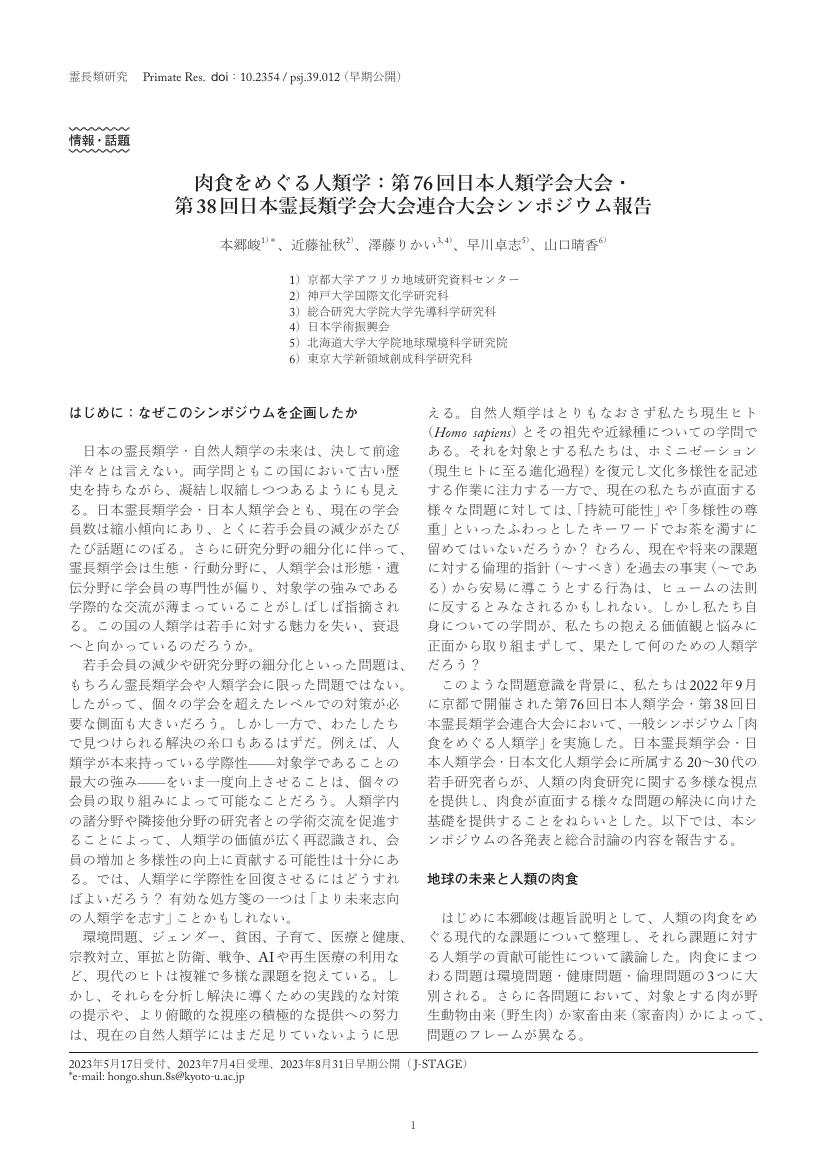15 0 0 0 進化・発達からみた感覚の多様性
- 著者
- .企画代表者(Representative Organizer):渥美 剛史 話題提供者(Speaker):渥美 剛史 早川 卓志 平松 千尋 生形 咲奈 指定討論者(Discussant):井手 正和 明和 政子 司会者(Chair):渥美 剛史
- 雑誌
- 日本心理学会第86回大会
- 巻号頁・発行日
- 2022-07-29
6 0 0 0 OA 霊長類分子生態学における次世代シークエンシング
- 著者
- 早川 卓志
- 出版者
- 一般社団法人 日本霊長類学会
- 雑誌
- 霊長類研究 (ISSN:09124047)
- 巻号頁・発行日
- vol.34, no.1, pp.65-78, 2018-06-20 (Released:2018-08-22)
- 参考文献数
- 102
- 被引用文献数
- 1
Genetic investigation of wild primates are crucial to understand kinship, population diversity, phylogeographic patterns, and heritable factors of phenotypes. Traditional DNA technology using polymerase chain reaction (PCR) and Sanger sequencing have restricted the genome-wide analysis of primates, particularly due to the low quality and low quantity of noninvasive DNA samples obtained from wild individuals. Following the post-genome era, next-generation sequencing (NGS) technologies have provided a new paradigm in primate studies. NGS has enabled the genome-wide analysis of primate DNA using noninvasive samples, such as feces. Metabarcoding and metagenomics analyses using fecal samples provide information on food items and commensal microorganisms of the host animal. Here, I review a history of DNA sequencing technologies and examples of NGS studies in wild primates. Further, I discuss the effectiveness of NGS application to noninvasive samples.
2 0 0 0 OA 霊長類分子生態学における次世代シークエンシング
- 著者
- 早川 卓志
- 出版者
- 一般社団法人 日本霊長類学会
- 雑誌
- 霊長類研究 (ISSN:09124047)
- 巻号頁・発行日
- pp.34.004, (Released:2018-06-27)
- 参考文献数
- 102
- 被引用文献数
- 1
Genetic investigation of wild primates are crucial to understand kinship, population diversity, phylogeographic patterns, and heritable factors of phenotypes. Traditional DNA technology using polymerase chain reaction (PCR) and Sanger sequencing have restricted the genome-wide analysis of primates, particularly due to the low quality and low quantity of noninvasive DNA samples obtained from wild individuals. Following the post-genome era, next-generation sequencing (NGS) technologies have provided a new paradigm in primate studies. NGS has enabled the genome-wide analysis of primate DNA using noninvasive samples, such as feces. Metabarcoding and metagenomics analyses using fecal samples provide information on food items and commensal microorganisms of the host animal. Here, I review a history of DNA sequencing technologies and examples of NGS studies in wild primates. Further, I discuss the effectiveness of NGS application to noninvasive samples.
- 著者
- 本郷 峻 近藤 祉秋 澤藤 りかい 早川 卓志 山口 晴香
- 出版者
- 一般社団法人 日本霊長類学会
- 雑誌
- 霊長類研究 (ISSN:09124047)
- 巻号頁・発行日
- pp.39.012, (Released:2023-08-31)
- 参考文献数
- 15
1 0 0 0 OA 腸内細菌叢からみた屋久島のニホンザルの採食生態
- 著者
- 澤田 晶子 栗原 洋介 早川 卓志
- 出版者
- 日本霊長類学会
- 雑誌
- 霊長類研究 Supplement 第32回日本霊長類学会大会
- 巻号頁・発行日
- pp.57, 2016-06-20 (Released:2016-09-21)
食物の消化吸収に密接に関連する腸内細菌叢は、長期の食事パターンの影響を強く受けることでも知られている。本研究では、季節に応じて様々な食物を食べる屋久島の野生ニホンザル(Macaca fuscata yakui)の腸内細菌叢が、葉食、果実・種子食、昆虫食といった採食パターンに応じてどのように変化するのか検証した。調査期間は2012年10月から2013年9月、調査対象であるオトナメス3個体から糞を採取し、次世代シークエンサーで網羅的に細菌種を同定した。エンテロタイプ(3種の細菌の比率に基づき区分される腸内細菌叢の型)に着目したところ、どの採食パターンにおいてもプレボテラタイプ(高炭水化物食と関連するエンテロタイプ)になり、採食時間の70%近くが昆虫食であった昆虫食期においても変化はみられなかった。一方、プレボテラタイプでは同じであっても、採食パターンによって細菌叢の構成が異なることがわかった。たとえば、葉食期にはセルロース分解菌を含むことで知られるトレポネーマ属の細菌種の増加がみられるが、これによりニホンザルは繊維含有量の高い葉を効率よく消化・吸収しているのではないかと推測する。
